Key takeaways:
- Multimedia in education enhances engagement and supports various learning styles through the integration of text, audio, video, and interactive elements.
- Incorporating multimedia improves retention and understanding, as students respond better to materials that combine different formats, like audio-visual presentations.
- Using tools like Canva and Adobe Spark allows educators to create captivating content, while feedback from students is crucial for refining multimedia strategies.
- Effective multimedia integration involves setting clear educational goals, varying media types for different learning preferences, and maintaining a balance between multimedia and traditional content.
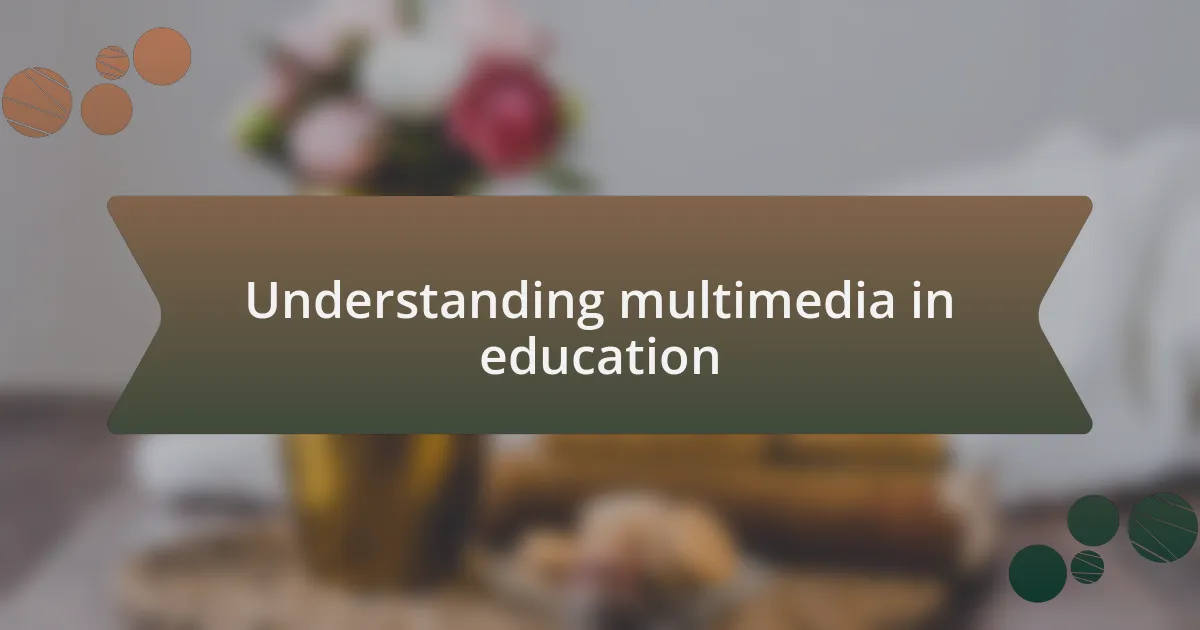
Understanding multimedia in education
Multimedia in education encompasses various forms of content such as text, audio, video, and interactive elements. This combination not only supports different learning styles but also engages students more effectively. I’ve often noticed that a well-placed video can spark curiosity in a seemingly mundane topic, transforming a passive learning experience into an interactive exploration.
Reflecting on my own experiences, I remember a particular history class where we watched a documentary segment about ancient civilizations. The visuals combined with narration helped me grasp complex concepts that I would have likely overlooked in a textbook. It’s fascinating to consider how these elements could evoke emotions or prompt critical thinking—isn’t it compelling to think about how a 3-minute clip could change a discussion in class?
Moreover, incorporating multimedia into textbooks can create a more personalized learning experience. For instance, I’ve seen students connect more deeply with subjects when they can choose how they engage with the material—whether through listening to a podcast episode or completing an interactive quiz. This flexibility not only caters to varied interests but also empowers learners to take charge of their own educational journeys.
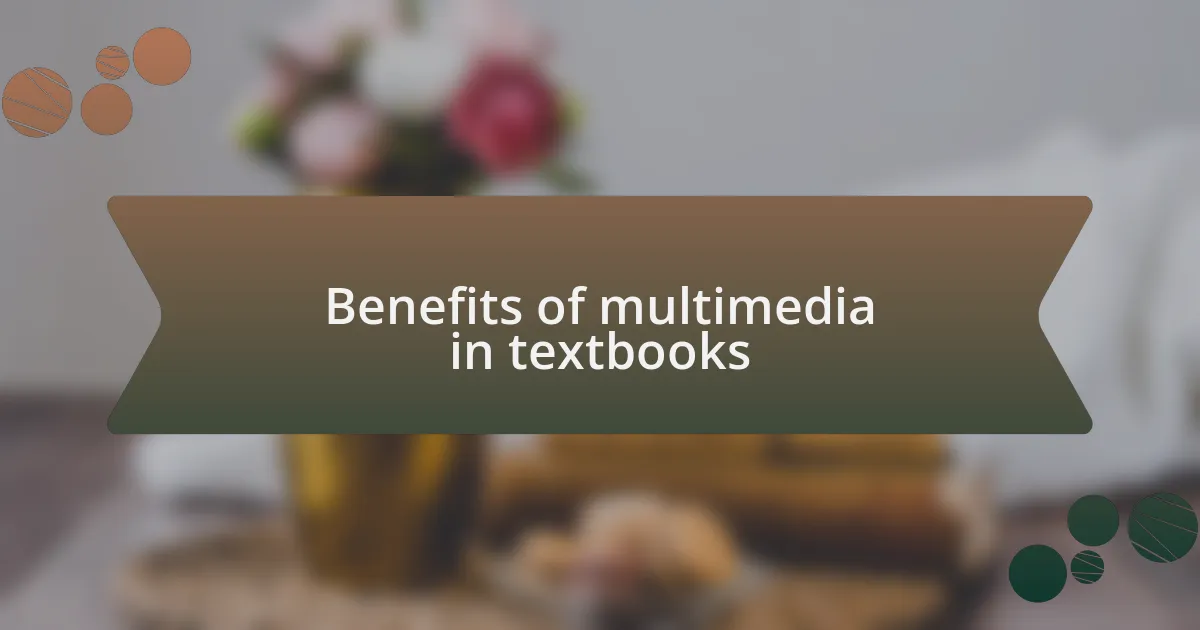
Benefits of multimedia in textbooks
Integrating multimedia into textbooks offers a dynamic approach to learning by addressing diverse educational needs. I’ve seen firsthand how incorporating interactive diagrams or simulations can illuminate topics that are otherwise hard to visualize. For example, in a science class, observing a chemical reaction through an animation made the process much clearer than static images ever could. Isn’t it fascinating how technology can turn abstract concepts into vivid experiences?
Another significant benefit is enhancing retention and understanding. When I reflect on my own learning, materials that combined audio and visuals always left a stronger impression than plain text. I recall studying literary themes through multimedia presentations, where soundtracks played while key scenes unfolded on screen. This combination didn’t just help me remember the content better; it also made the emotional underpinnings of the story resonate deeply with me.
Moreover, multimedia elements can foster collaboration among students. In group projects, I’ve noticed that peers are more engaged when they create presentations featuring videos or interactive quizzes. They not only share knowledge but also develop teamwork skills, which are crucial for their futures. With such effective tools at their disposal, why wouldn’t we embrace a more engaging and collaborative learning atmosphere in textbooks?
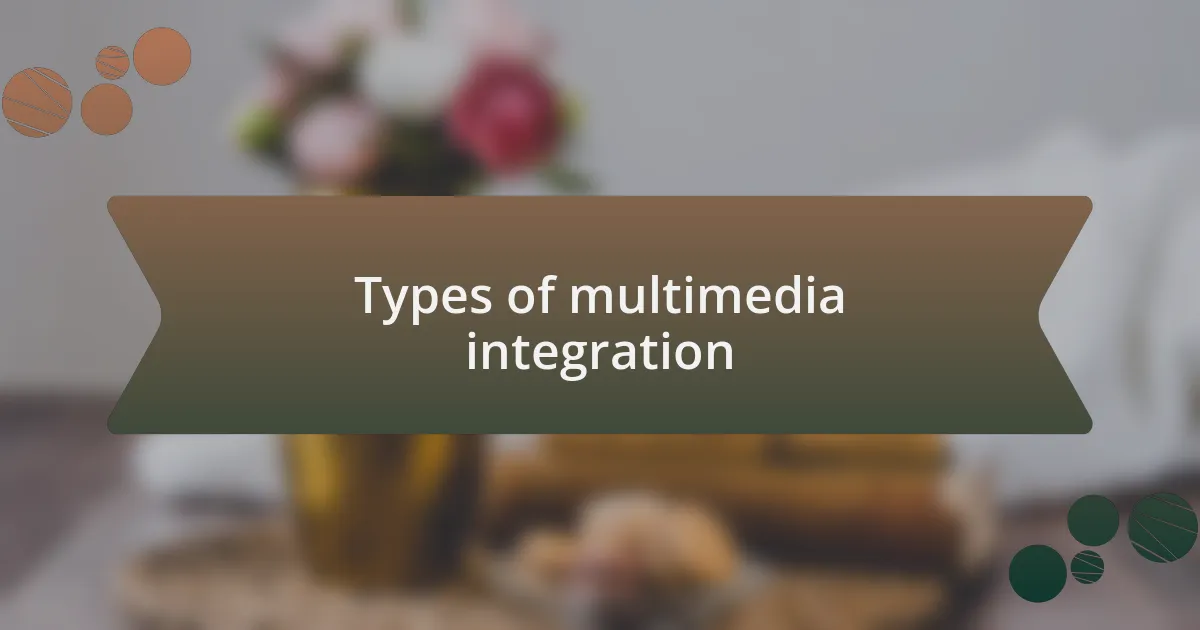
Types of multimedia integration
When discussing types of multimedia integration, one fascinating approach is the use of video. I’ve often found that a well-chosen video can act as a powerful storytelling tool, enhancing comprehension in ways that words alone sometimes struggle to achieve. For example, during a history lesson, watching a documentary clip about a pivotal event allowed students to emotionally connect with the past, making the facts more relatable and memorable. Don’t you think experiencing history through moving images just feels more alive?
Another impactful method is the incorporation of interactive elements, such as quizzes and simulations. I remember introducing a math concept using an interactive software that visualized problems in real-time. It transformed an abstract equation into a tangible scenario where students could manipulate variables. Watching their engagement levels rise as they experimented with different outcomes was utterly rewarding. Isn’t it amazing how hands-on experiences can spark curiosity and deepen understanding?
Infographics also play a crucial role in integrating multimedia. I’ve always appreciated how they condense complex information into visually appealing formats. For instance, while teaching environmental science, I used an infographic to present data on climate change, combining charts, images, and text in a digestible format. The students were captivated, and many later expressed that they preferred studying from visuals rather than dense paragraphs. Doesn’t it make sense that our brains are naturally wired to process visuals more quickly?
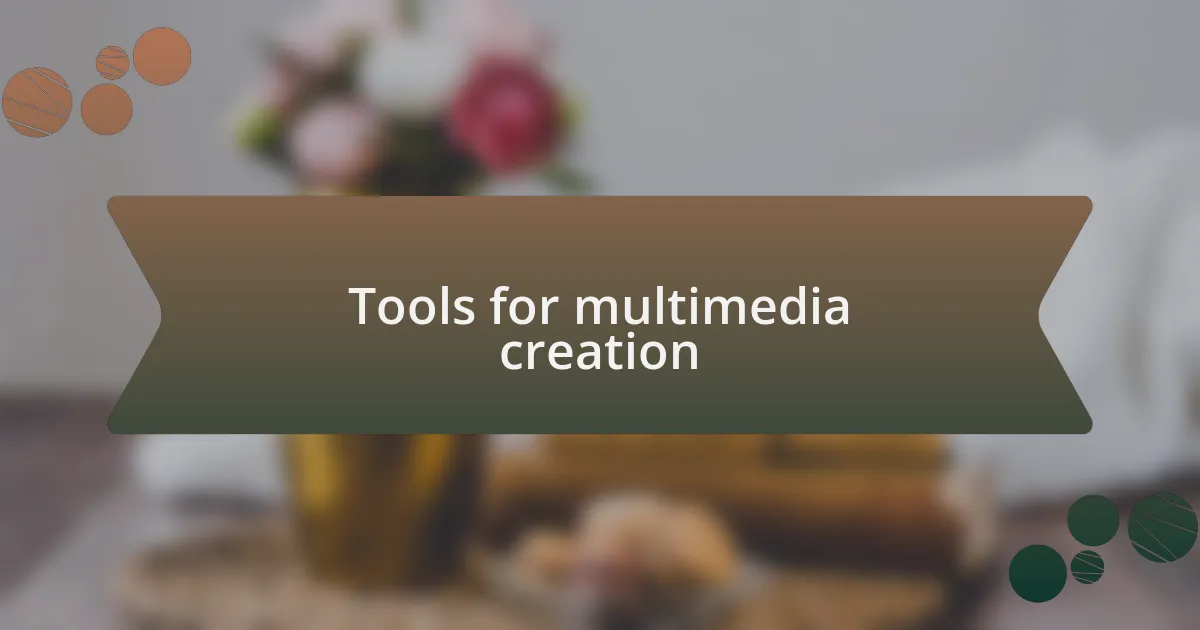
Tools for multimedia creation
Creating multimedia content requires the right tools, and I have discovered several that make the process both efficient and enjoyable. For instance, I often turn to Canva for designing visuals. Its intuitive interface allows me to create eye-catching graphics quickly, which is especially useful when I want to summarize key concepts from a lesson. Have you ever tried transforming static information into a vibrant poster? It really shifts the teaching dynamic.
Another invaluable tool I’ve embraced is Adobe Spark. This platform enables me to produce stunning short videos that complement textbook material. I vividly recall crafting a quick animated introduction to a chapter about the solar system. The excitement in my students’ eyes when they saw the planets come to life was truly special. Isn’t it fascinating how a simple video can ignite students’ imaginations and drive their curiosity?
For creating interactive content, I highly recommend using Articulate or H5P. They provide user-friendly templates that help me develop quizzes and interactive activities seamlessly. I still remember designing an interactive timeline for a literature unit that allowed students to explore character developments and plot twists. The feedback was overwhelmingly positive, with many expressing how fun it was to engage with the material. Don’t you think that mixing learning with fun can open up new levels of understanding?
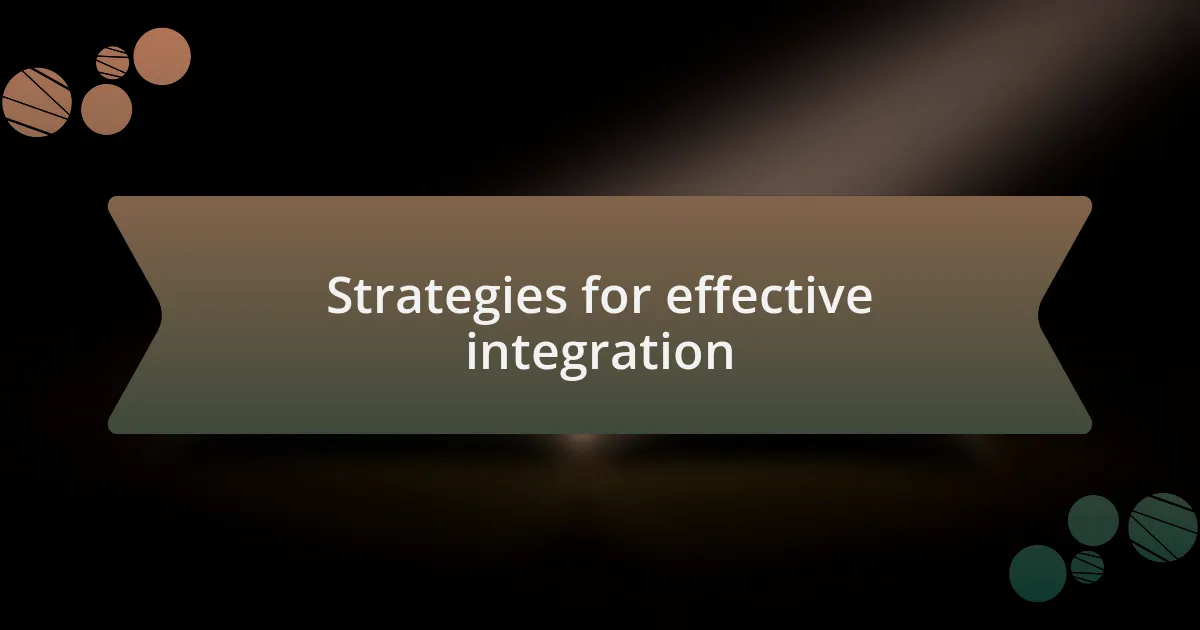
Strategies for effective integration
One effective strategy for multimedia integration is to design content with clear educational goals in mind. I always start by asking myself how each multimedia element enhances understanding or engagement. For example, when I included infographics in my history textbook, I ensured they highlighted critical timelines and events. This not only made the information more digestible but also sparked discussions among students—how do visuals shape our understanding of complex subjects?
Another approach is to vary the types of media used, catering to different learning styles. I discovered this when I incorporated podcasts into my language arts curriculum. Hearing authors discuss their work brought literature to life, making it more relatable. It was rewarding to see students who typically struggled with reading find a new avenue for engagement. Have you ever noticed how a different medium can unlock a student’s interest?
Lastly, feedback is crucial for refining multimedia integration strategies. I regularly solicit student input after using new tools or formats. For instance, after launching a video series on science experiments, I created a survey to gather insights on what resonated with them. The data helped me tweak future content, making it more aligned with their preferences. Isn’t it enlightening to see how collaboration can enhance our teaching practices?

Personal experiences in multimedia use
When I first experimented with integrating interactive quizzes into my math textbooks, the transformation was remarkable. I vividly remember the moment a student exclaimed, “This makes it feel like a game!” That excitement was a clear signal for me. It showed just how engaging educational content can become when students can actively participate rather than passively consume information. Have you ever seen a shift in engagement just through a simple format change?
In another instance, I created a virtual field trip for my geography class. Watching students collaborate in real-time while exploring new locations online was thrilling. They bonded over sharing their thoughts and discoveries. It made me realize how multimedia can not only convey information but also foster camaraderie among students. Isn’t it fascinating how shared experiences can deepen learning?
I also had a moment of realization after introducing animation in a biology section about cellular processes. One student, who often struggled with abstract concepts, lit up when the processes unfolded visually. His confidence grew, leading him to contribute ideas during discussions. This taught me an invaluable lesson: multimedia can bridge gaps and make even the toughest subjects accessible. Don’t you think that seeing enthusiasm in students is the ultimate reward for any educator?

Tips for successful implementation
When implementing multimedia in textbooks, I found that starting small can lead to impactful changes. For instance, I began by integrating simple videos alongside complex topics, which eased students into the idea. It was rewarding to witness their reactions; one student said, “This makes everything so much clearer!” Have you ever noticed how a well-placed video can shift comprehension dramatically?
Another strategy I employed involved gathering student feedback after each multimedia addition. After I introduced an interactive simulation in a physics chapter, the insights were invaluable. Students expressed their preference for more hands-on activities, which highlighted the importance of involving them in the development process. I realized that listening to their voices not only enhances engagement but also fosters a sense of ownership in their learning journey. Don’t you agree that when students feel heard, they are more invested?
Lastly, it’s essential to maintain a balance between multimedia and traditional content. When I once overloaded a unit with too many interactive elements, I noticed students struggled to keep track of key information. It taught me that while multimedia can enhance learning, it shouldn’t overwhelm. How can we strike the right balance to create a harmonious experience? Understanding this balance has made a significant difference in how I approach future projects.